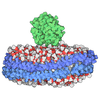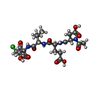+ Open data
Open data
- Basic information
Basic information
| Entry | Database: PDB / ID: 4quj | ||||||
|---|---|---|---|---|---|---|---|
| Title | Caspase-3 T140GV266H | ||||||
 Components Components |
| ||||||
 Keywords Keywords | hydrolase/hydrolase inhibitor / Allosteric Network / hydrolase-hydrolase inhibitor complex | ||||||
| Function / homology |  Function and homology information Function and homology informationcaspase-3 / phospholipase A2 activator activity / Stimulation of the cell death response by PAK-2p34 / anterior neural tube closure / intrinsic apoptotic signaling pathway in response to osmotic stress / leukocyte apoptotic process / positive regulation of pyroptotic inflammatory response / glial cell apoptotic process / NADE modulates death signalling / luteolysis ...caspase-3 / phospholipase A2 activator activity / Stimulation of the cell death response by PAK-2p34 / anterior neural tube closure / intrinsic apoptotic signaling pathway in response to osmotic stress / leukocyte apoptotic process / positive regulation of pyroptotic inflammatory response / glial cell apoptotic process / NADE modulates death signalling / luteolysis / response to cobalt ion / cellular response to staurosporine / death-inducing signaling complex / cyclin-dependent protein serine/threonine kinase inhibitor activity / Apoptosis induced DNA fragmentation / Apoptotic cleavage of cell adhesion proteins / Caspase activation via Dependence Receptors in the absence of ligand / SMAC, XIAP-regulated apoptotic response / Activation of caspases through apoptosome-mediated cleavage / Signaling by Hippo / SMAC (DIABLO) binds to IAPs / SMAC(DIABLO)-mediated dissociation of IAP:caspase complexes / death receptor binding / axonal fasciculation / regulation of synaptic vesicle cycle / fibroblast apoptotic process / epithelial cell apoptotic process / platelet formation / negative regulation of cytokine production / Other interleukin signaling / response to anesthetic / execution phase of apoptosis / positive regulation of amyloid-beta formation / Apoptotic cleavage of cellular proteins / negative regulation of B cell proliferation / pyroptotic inflammatory response / neurotrophin TRK receptor signaling pathway / negative regulation of activated T cell proliferation / T cell homeostasis / response to tumor necrosis factor / negative regulation of cell cycle / B cell homeostasis / cell fate commitment / response to X-ray / Pyroptosis / regulation of macroautophagy / Caspase-mediated cleavage of cytoskeletal proteins / response to amino acid / response to glucose / response to UV / keratinocyte differentiation / Degradation of the extracellular matrix / striated muscle cell differentiation / intrinsic apoptotic signaling pathway / response to glucocorticoid / protein maturation / erythrocyte differentiation / response to nicotine / hippocampus development / apoptotic signaling pathway / enzyme activator activity / response to hydrogen peroxide / protein catabolic process / sensory perception of sound / regulation of protein stability / protein processing / response to wounding / neuron differentiation / response to estradiol / peptidase activity / positive regulation of neuron apoptotic process / heart development / protease binding / neuron apoptotic process / response to lipopolysaccharide / aspartic-type endopeptidase activity / learning or memory / response to hypoxia / postsynaptic density / response to xenobiotic stimulus / cysteine-type endopeptidase activity / neuronal cell body / apoptotic process / DNA damage response / protein-containing complex binding / glutamatergic synapse / proteolysis / nucleoplasm / nucleus / cytosol / cytoplasm Similarity search - Function | ||||||
| Biological species |  Homo sapiens (human) Homo sapiens (human) | ||||||
| Method |  X-RAY DIFFRACTION / X-RAY DIFFRACTION /  SYNCHROTRON / SYNCHROTRON /  MOLECULAR REPLACEMENT / Resolution: 1.498 Å MOLECULAR REPLACEMENT / Resolution: 1.498 Å | ||||||
 Authors Authors | Cade, C. / Swartz, P.D. / MacKenzie, S.H. / Clark, A.C. | ||||||
 Citation Citation |  Journal: Biochemistry / Year: 2014 Journal: Biochemistry / Year: 2014Title: Modifying caspase-3 activity by altering allosteric networks. Authors: Cade, C. / Swartz, P. / MacKenzie, S.H. / Clark, A.C. | ||||||
| History |
|
- Structure visualization
Structure visualization
| Structure viewer | Molecule:  Molmil Molmil Jmol/JSmol Jmol/JSmol |
|---|
- Downloads & links
Downloads & links
- Download
Download
| PDBx/mmCIF format |  4quj.cif.gz 4quj.cif.gz | 73.2 KB | Display |  PDBx/mmCIF format PDBx/mmCIF format |
|---|---|---|---|---|
| PDB format |  pdb4quj.ent.gz pdb4quj.ent.gz | 52.7 KB | Display |  PDB format PDB format |
| PDBx/mmJSON format |  4quj.json.gz 4quj.json.gz | Tree view |  PDBx/mmJSON format PDBx/mmJSON format | |
| Others |  Other downloads Other downloads |
-Validation report
| Summary document |  4quj_validation.pdf.gz 4quj_validation.pdf.gz | 453.4 KB | Display |  wwPDB validaton report wwPDB validaton report |
|---|---|---|---|---|
| Full document |  4quj_full_validation.pdf.gz 4quj_full_validation.pdf.gz | 456.1 KB | Display | |
| Data in XML |  4quj_validation.xml.gz 4quj_validation.xml.gz | 16.3 KB | Display | |
| Data in CIF |  4quj_validation.cif.gz 4quj_validation.cif.gz | 22.5 KB | Display | |
| Arichive directory |  https://data.pdbj.org/pub/pdb/validation_reports/qu/4quj https://data.pdbj.org/pub/pdb/validation_reports/qu/4quj ftp://data.pdbj.org/pub/pdb/validation_reports/qu/4quj ftp://data.pdbj.org/pub/pdb/validation_reports/qu/4quj | HTTPS FTP |
-Related structure data
| Related structure data |  4qtxC  4qtyC  4qu0C  4qu5C  4qu8C  4qu9C  4quaC  4qubC  4qudC  4queC  4qugC  4quhC  4quiC  4qulC C: citing same article ( |
|---|---|
| Similar structure data |
- Links
Links
- Assembly
Assembly
| Deposited unit | 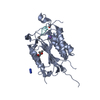
| ||||||||
|---|---|---|---|---|---|---|---|---|---|
| 1 | 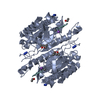
| ||||||||
| Unit cell |
| ||||||||
| Components on special symmetry positions |
|
- Components
Components
-Protein / Protein/peptide , 2 types, 2 molecules AF
| #1: Protein | Mass: 31785.043 Da / Num. of mol.: 1 / Mutation: T140G V266H Source method: isolated from a genetically manipulated source Source: (gene. exp.)  Homo sapiens (human) / Gene: CASP3, CPP32 / Production host: Homo sapiens (human) / Gene: CASP3, CPP32 / Production host:  |
|---|---|
| #2: Protein/peptide | |
-Non-polymers , 4 types, 253 molecules 
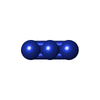
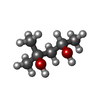




| #3: Chemical | ChemComp-NA / | ||||
|---|---|---|---|---|---|
| #4: Chemical | | #5: Chemical | ChemComp-MPD / ( | #6: Water | ChemComp-HOH / | |
-Details
| Has protein modification | Y |
|---|
-Experimental details
-Experiment
| Experiment | Method:  X-RAY DIFFRACTION / Number of used crystals: 1 X-RAY DIFFRACTION / Number of used crystals: 1 |
|---|
- Sample preparation
Sample preparation
| Crystal | Density Matthews: 2.16 Å3/Da / Density % sol: 43.13 % |
|---|---|
| Crystal grow | Temperature: 291 K / Method: vapor diffusion, hanging drop / pH: 8.5 Details: Proteins were dialyzed in a buffer of 10 mM Tris-HCl, pH 8.5, 1 mM DTT and concentrated to 10 mg/mL. Inhibitor, Ac-DEVD-CMK reconstituted in DMSO, was then added at a 5:1 inhibitor:peptide ...Details: Proteins were dialyzed in a buffer of 10 mM Tris-HCl, pH 8.5, 1 mM DTT and concentrated to 10 mg/mL. Inhibitor, Ac-DEVD-CMK reconstituted in DMSO, was then added at a 5:1 inhibitor:peptide ratio (w/w). The protein was diluted to a concentration of 8 mg/mL by adding 10 mM Tris-HCl, pH 8.5, concentrated DTT, and concentrated NaN3 so that the final buffer consisted of 10 mM Tris-HCl, pH 8.5, 10 mM DTT, and 3 mM NaN3. Crystals were obtained at 291K by the hanging drop vapor diffusion method using 4 L drops that contained equal volumes of protein and reservoir solutions over a 0.5 mL reservoir. The reservoir solutions for optimal crystal growth consisted of 100 mM sodium citrate, pH 5.0, 3 mM NaN3, 10 mM DTT, and 10% 16% PEG 6000 (w/v). Crystals appeared within 3.5 to 6 weeks for all mutants, VAPOR DIFFUSION, HANGING DROP |
-Data collection
| Diffraction | Mean temperature: 100 K | |||||||||||||||||||||
|---|---|---|---|---|---|---|---|---|---|---|---|---|---|---|---|---|---|---|---|---|---|---|
| Diffraction source | Source:  SYNCHROTRON / Site: SYNCHROTRON / Site:  APS APS  / Beamline: 22-BM / Wavelength: 1 Å / Beamline: 22-BM / Wavelength: 1 Å | |||||||||||||||||||||
| Detector | Type: MARMOSAIC 225 mm CCD / Detector: CCD / Date: Feb 20, 2013 | |||||||||||||||||||||
| Radiation | Monochromator: Bending magnet / Protocol: SINGLE WAVELENGTH / Monochromatic (M) / Laue (L): M / Scattering type: x-ray | |||||||||||||||||||||
| Radiation wavelength | Wavelength: 1 Å / Relative weight: 1 | |||||||||||||||||||||
| Reflection | Resolution: 1.498→33.782 Å / Num. all: 44913 / Num. obs: 44913 / % possible obs: 98.99 % / Observed criterion σ(F): 2 / Observed criterion σ(I): 2 | |||||||||||||||||||||
| Reflection shell |
|
- Processing
Processing
| Software |
| |||||||||||||||||||||||||||||||||||||||||||||||||||||||||||||||||||||||||||||||||||||||||||||||||||||||||
|---|---|---|---|---|---|---|---|---|---|---|---|---|---|---|---|---|---|---|---|---|---|---|---|---|---|---|---|---|---|---|---|---|---|---|---|---|---|---|---|---|---|---|---|---|---|---|---|---|---|---|---|---|---|---|---|---|---|---|---|---|---|---|---|---|---|---|---|---|---|---|---|---|---|---|---|---|---|---|---|---|---|---|---|---|---|---|---|---|---|---|---|---|---|---|---|---|---|---|---|---|---|---|---|---|---|---|
| Refinement | Method to determine structure:  MOLECULAR REPLACEMENT / Resolution: 1.498→33.782 Å / SU ML: 0.11 / σ(F): 1.34 / Phase error: 17.66 / Stereochemistry target values: ML MOLECULAR REPLACEMENT / Resolution: 1.498→33.782 Å / SU ML: 0.11 / σ(F): 1.34 / Phase error: 17.66 / Stereochemistry target values: ML
| |||||||||||||||||||||||||||||||||||||||||||||||||||||||||||||||||||||||||||||||||||||||||||||||||||||||||
| Solvent computation | Shrinkage radii: 0.9 Å / VDW probe radii: 1.11 Å / Solvent model: FLAT BULK SOLVENT MODEL | |||||||||||||||||||||||||||||||||||||||||||||||||||||||||||||||||||||||||||||||||||||||||||||||||||||||||
| Refinement step | Cycle: LAST / Resolution: 1.498→33.782 Å
| |||||||||||||||||||||||||||||||||||||||||||||||||||||||||||||||||||||||||||||||||||||||||||||||||||||||||
| Refine LS restraints |
| |||||||||||||||||||||||||||||||||||||||||||||||||||||||||||||||||||||||||||||||||||||||||||||||||||||||||
| LS refinement shell |
|
 Movie
Movie Controller
Controller



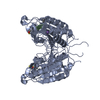
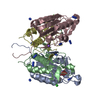
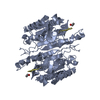


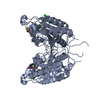

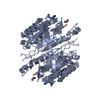

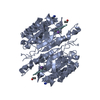
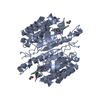


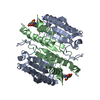

 PDBj
PDBj














